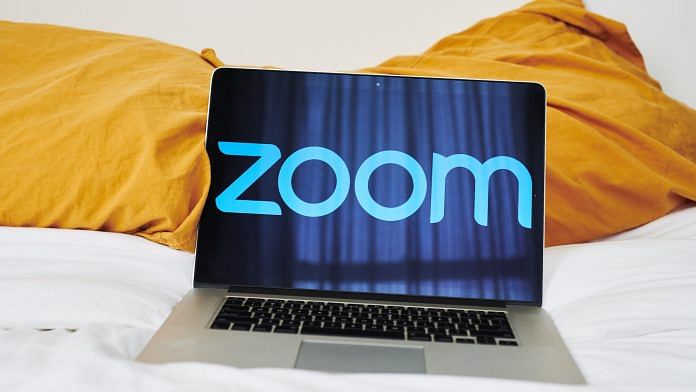In Lewis Carroll’s Victorian classic Through the Looking-Glass, Alice steps through a mirror into a world that is a reflection of the one she already exists in.
This fictional account of a familiar yet topsy-turvy reality resonates with our lived experiences during the pandemic, where we must navigate work, school and leisure through a screen.
Using our combined observations of hundreds of Zoom meetings and scholarly insights from the fields of anthropology and psychology, we explore these questions to consider the transformative impact of digital platforms on our work environments and identities.
As the legendary Aretha Franklin asks, “who’s zoomin’ who,” and why? And what does this tell us about our pandemic selves?
Men prefer custom backgrounds
Based on our experiences in the new virtual world, men appear to far outnumber women in their preference for using specialty Zoom backgrounds. Popular choices include dungeons, outer space, landscapes and branded University images, the latter of which is common among men in positions of significant power. They sometimes switch designs during meetings, which can be humorous and reflect individual creativity.
In practical terms, the backgrounds may also be used to disguise cluttered or untidy workspaces. The lack of research on Zoom backgrounds makes determining the reasons behind this behaviour challenging to ascertain, but studies about gender and workspace culture may offer some clues.
The idea of men customizing their backgrounds to assert themselves in new spaces aligns with insights from gaming literature. Journalist Gabriel Winslow-Yost argues that gaming can be very grounding among male players given the collective nature of the virtual landscape and the definitive roles each player has.
Unlike video games, Zoom meetings are not usually perceived as leisurely activities or an escape from the “real” world. However, it could be that tech-savvy men are drawn to or comforted in some way by the opportunity to curate their digital environments using unique Zoom backgrounds, or as Winslow-Yost points out with regard to the online gaming world: “… they let us spend a little time in a different room.”
Designs by men
Women have been players in the corporate world for decades, but the style and appearance of many work environments remains quite masculine. This is reflected in the predominance of neutral tones like steely grey, along with Modernist décor and room temperatures two to three degrees lower than what women prefer.
During the pandemic, the spatial distinctions between office and home are eroding because many of us now work in the places where we live. This transition may be especially challenging for men, who mostly prefer clear definitions between office and domestic spaces. In light of this, one suggestion is that men may use specialty Zoom backgrounds as a creative way to exact a sense of control over their new work environments that no longer reflect the masculine design they are used to.
On-screen appearances
We are also regularly observing and being observed by people on the other side of our looking-glass screens, which can increase our focus on the appearance of others and generate discomfort about how we look. There’s a reason cosmetic surgery for facial procedures has skyrocketed since the uptick in Zoom use or “Zoom boom.”
Women are regularly objectified and sexualized for male pleasure or gain, which researchers refer to as the male gaze. This could help explain why women are less likely than men to turn their videos on during Zoom calls. Their decisions to do so stem from appearance-related concerns and, for some, a desire to multi-task, says Portland-based psychologist and tech expert Doreen Dodgen-Magee.
When using Zoom, many of our male colleagues report feeling uncomfortable with being continuously observed. Given this, it is conceivable that some men employ custom backgrounds as protective camouflage to reduce their vulnerability in a glaringly objectified space.
Being visually assessed in such overt ways is not something most men are familiar with, especially in their professional lives. This is demonstrated in a recent study that found that although female workers often perceive themselves to be observed in certain working environments males do not.
Screen reflections
Like Alice’s looking-glass, Zoom is transforming how we observe one another and construct or reconstruct our identities during the COVID-19 pandemic. The insights shared here suggest some of the ways that gender shapes the uptake of this platform among women and men.
Further research would be fascinating to conduct, particularly alongside our male and gender variant colleagues who can shed additional light on how creativity and resilience are used to fashion and secure Zoom-hood in our digital world.![]()
Treena Orchard, Associate Professor, School of Health Studies, Western University and Shauna Burke, Associate professor, School of Health Studies, Western University
This article is republished from The Conversation under a Creative Commons license. Read the original article.
Also read: India’s Zoom wedding experiment fizzled out. It didn’t have that four-day hangover







Such trash
In my class it’s the opposite, most girls keep videos on while almost all boys keep it off